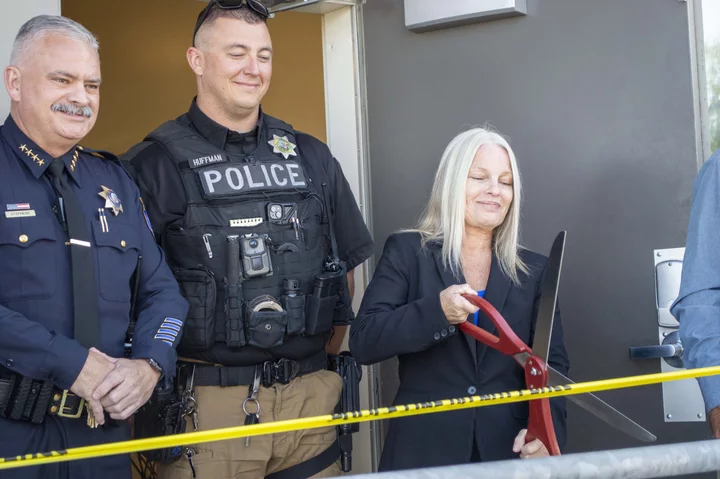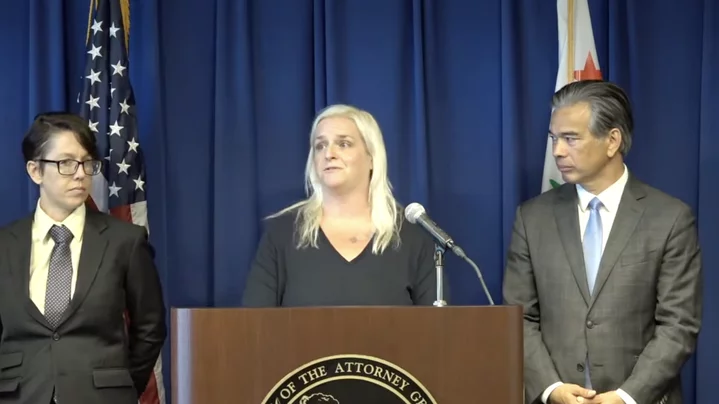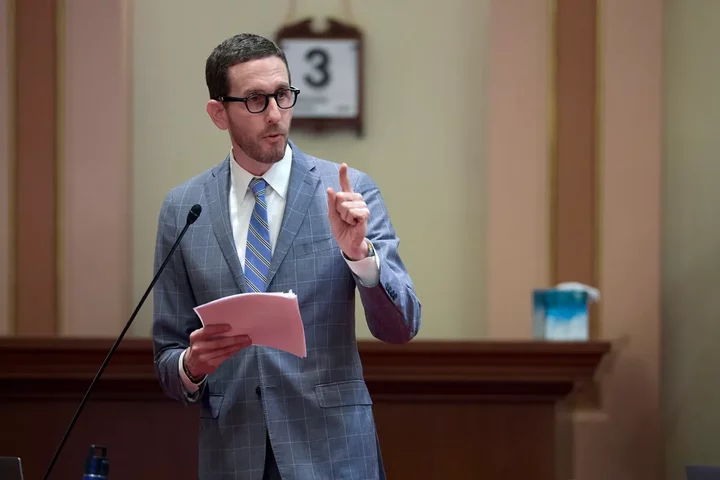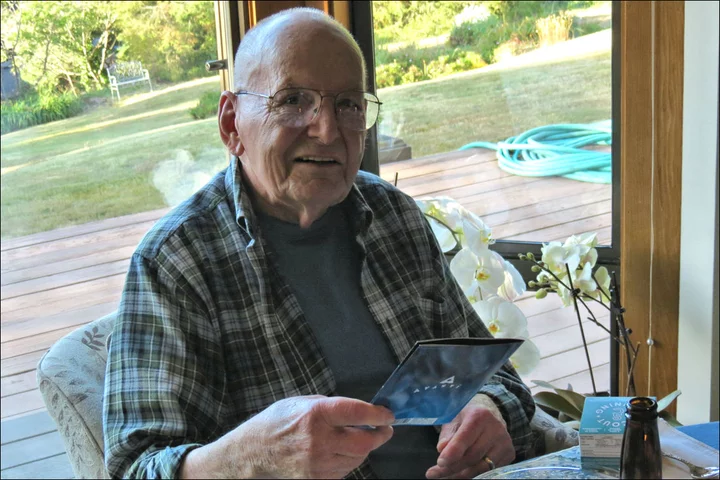CHP Identifies Motorcyclist Killed on Highway 299 Near Trinity County Line Last Night
LoCO Staff / Thursday, Oct. 3, 2024 @ 1:06 p.m. / Traffic
California Highway Patrol release:
On October 2, 2024, at approximately 1930 hours, CHP Trinity River Area units were notified by CHP Redding Communications Center of a traffic crash involving a motorcycle in the area of SR-299 and Burnt Ranch. The crash scene was located on SR-299 at mile post marker 299 TRI 12.97 (Trinity County). CHP, Hawkins Bar Volunteer Fire, and a Hoopa Valley Ambulance responded to the scene to provide medical and traffic control services.
CHP units arrived on scene at 1946 hours and assumed Incident Command. Through investigation, it was determined the driver and sole occupant of the motorcycle, David Wilkie, had been traveling westbound on SR-299. For reasons still under investigation, Wilkie lost control of his motorcycle and drove off the south roadway edge of SR-299. The motorcycle collided with the steep ascending rock embankment, which ultimately caused Wilkie to be ejected from the motorcycle and collide with the embankment. Emergency personnel and civilians who witnessed the crash performed CPR and life saving efforts for approximately 30 minutes. Wilkie unfortunately succumbed to his injuries sustained as a result of this crash and was pronounced deceased at the scene. Wilkie was wearing a DOT approved helmet at the time of this crash and it is unknown at this point if alcohol or drugs are a contributing factor.
This crash remains under investigation by the CHP Trinity River Area office.
Trinity River CHP would like to thank our allied agencies for their assistance with this incident and express our sympathy to Mr. Wilkie’s family in the loss of their loved one.
BOOKED
Today: 6 felonies, 12 misdemeanors, 0 infractions
JUDGED
Humboldt County Superior Court Calendar: Today
CHP REPORTS
Briceland Thorn Rd / Seely Rd (HM office): Trfc Collision-Minor Inj
0 Us101 S (HM office): Trfc Collision-No Inj
800 Mm199 N Dn 8.00 (HM office): Trfc Collision-1141 Enrt
6100 Mm101 N Hum 61.00 (HM office): Assist CT with Maintenance
Sr299 / Sr3 (RD office): Assist CT with Maintenance
9100 Mm101 N Men T91.00 (HM office): Assist CT with Maintenance
ELSEWHERE
County of Humboldt Meetings: Fish & Game Advisory Commission Agenda - Regular Meeting
County of Humboldt Meetings: Behavioral Health Board Executive Committee Meeting - Sept. 3, 2025
Governor’s Office: Governor Newsom proclaims California Farmworker Day
KINS’s Talk Shop: Talkshop August 26th, 2025 – Gary Storts
The City of Eureka’s Street Teams Have a New Home Office on the Waterfront
Dezmond Remington / Thursday, Oct. 3, 2024 @ 11:51 a.m. / Local Government
Eureka Police Chief Brian Stephens and CSET’s Dillon Huffman are all smiles as Mayor Kim Bergel cuts the ceremonial tape. Photo: Dezmond Remington.
Two social service programs celebrated an official grand opening of their (sort of) new location this morning when mayor Kim Bergel cut the “Police Line — Do Not Cross” tape on the Waterfront Annex.
Crisis Alternative Response of Eureka’s (CARE) new-ish location at 7 Commercial, near the Vista Del Mar. It shares the building with the Community Safety Engagement Team (CSET). Both teams work closely with one another, so city manager Miles Slattery told the Outpost that it made sense for them to be in the same building. The location was selected because most of the calls for their services are around the area where the new building is.
CSET has been based out of the location for five months and CARE for three, but the ribbon cutting wasn’t until today because it’s taken some time to refurbish the space and put up some signage. The move and upkeep was paid for by 2020’s Measure H and American Rescue Plan Act funds.
“This is an opportunity for our teams to be together in the same location and to be able to work better together,” Bergel said. “It’s going to be an amazing opportunity. We’re down where we can meet people where we’re at. I’m just so forever grateful that we have moved in this direction with our department and that we are making a difference every day. I think this is one more opportunity to move that in the right direction.”
The Eureka Police Department runs CSET, and CARE is a division of Eureka city government. CARE provides mobile mental health services, such as sending clinicians to 911 calls or helping people find more permanent psychological health. CSET focuses on homeless crime and quality-of-life issues in Old Town Eureka, the waterfront and city parks.
Providence Offers ‘Profound Apologies’ to Woman Denied Emergency Abortion Care at St. Joseph Hospital
Ryan Burns / Thursday, Oct. 3, 2024 @ 10:32 a.m. / Health Care
Eureka chiropractor Anna Nusslock speaking at a press conference with California Attorney General Rob Bonta on Monday. | Screenshot.
PREVIOUSLY: Attorney General Sues St. Joseph Hospital for Denying a Woman Emergency Abortion Care
###
Earlier this week, after being sued by the State of California for refusing emergency abortion care to a woman whose water had broken months prematurely, executives with the Catholic health care system Providence reached out to her in an effort to apologize, according to a statement forwarded to the Outpost by Providence’s national public relations office.
On Tuesday, one day after the state’s suit was filed here in Humboldt County Superior Court, Providence Northern California Service Area Chief Executive Garry Olney sent the following message to all Providence employees in the Northern California Service Area:
As you have likely heard, yesterday we learned that the California attorney general filed a lawsuit alleging that we denied emergency care to a pregnant patient in Humboldt County earlier this year.
We are heartbroken over the experience this patient had while in our care and reached out to her today in an effort to express our profound apologies.
This was a tragic situation that did not meet our high standards for safe, quality, compassionate care. We are immediately re-visiting our training, education and escalation processes in emergency medical situations to ensure that this does not happen again and to ensure that our care teams have the training and support they need to deliver the best possible care for each patient we serve.
As devasted [sic] as we are, we can’t begin to imagine what the patient and her family have been through. We will learn from this and renew our commitment to ensuring that the care and experience we deliver are aligned with our high standards, every time and in every care setting.
###
Below is video of California Attorney General Rob Bonta’s Monday press conference with Eureka chiropractor Anna Nusslock, the woman who was allegedly denied the emergency abortion care. Nusslock tells her story in her own words starting shortly after the 13-minute mark:
EAT UP THE TOWN! Eureka’s Taste of Main Street Returns for the First Time in Four Years
LoCO Staff / Thursday, Oct. 3, 2024 @ 10:05 a.m. / Food
Press release from Eureka Main Street:
Eureka Main Street is thrilled to announce the highly anticipated return of Taste of Main Street on Thursday, October 3, 2024, from 5 PM to 8 PM. This beloved event invites food lovers to indulge in a culinary adventure throughout the vibrant Downtown and Old Town Eureka districts. Guests can savor mouthwatering bites from over fifteen participating restaurants, including favorites like Familia Cafe, Wok In Wok Out Asian Eatery, The Hood Eureka, Dick Taylor Craft Chocolate, GuateMayan Yum Yums, Taco Town Fruteria, Kaptain’s Quarters, The Madrone Brick Fire Pizza & Taphouse, Living the Dream Ice Cream, Los Bagels, The Greene Lily Café, Surfside Burger Shack and Sweet Greens Juice Bar—all for just $35 per ticket.
“Taste of Main Street is a celebration of our local culinary scene and an excellent opportunity for restaurants to showcase their signature dishes,” said Amanda Kruschke, Executive Director of Eureka Main Street. “We can’t wait to bring our community together for an evening of fun, food, and connection!”
Event Highlights:
- Date: Thursday, October 3, 2024
- Time: 5 PM - 8 PM
- Location: Downtown and Old Town Eureka
- Ticket Price: $35
- Pick-Up Information: Tickets must be picked up at the Eureka Welcome Center (108 F Street) from October 1st to 3rd.
Tickets can be purchased online at NorthCoastTickets.com or in person at the Eureka Welcome Center. Guests are encouraged to act quickly, as tickets are expected to sell out fast!
In addition to tantalizing food, the event promises a lively atmosphere, making it a perfect outing for friends, families, and food enthusiasts alike. Guests will receive a map of participating restaurants and can present their tickets at each location to enjoy delicious “tastes” from each establishment. Note: Valid IDs are required for alcoholic beverage tastings.
Taste of Main Street also serves as the kickoff for the Redwood Coast Music Festival, which runs from October 3-6 and features four days of live music across seven venues, showcasing over 100 sets of New Orleans Jazz, Blues, Swing, Zydeco, Western Swing, Rockabilly, Americana, and more! For more information about the music festival and to purchase tickets, visit rcmfest.org.
For more updates about Taste of Main Street, follow Eureka Main Street on social media or contact us at 707-441-4187 or eurekamainstreet@eurekaca.gov.
Join us for a night of unforgettable flavors, community spirit, and fun at Taste of Main Street 2024—Mmmm…Tasty!
GUEST OPINION: Not So Fast!
Carol Moné / Thursday, Oct. 3, 2024 @ 7:15 a.m. / Guest Opinion
Social media sites are ablaze with complaints about speeding. Near misses, run-over kitties and general anger at speeders get lots of attention. Nobody, except perhaps a speeder, likes speeders.
What
can we do to stop speeders? Most of the commonly suggested solutions
don’t work. Signs are ignored. Policing traffic is an additional
burden to already underfunded police forces. Being pulled over
frightens a good portion of the community. Harsh penalties, meaning
costly tickets, are not effective for people who can afford fines.
And people who can afford fines are frequently also people who can
afford hot cars that go fast.
What does work is good road design. Given a wide, straight, smoothly-paved asphalt expanse, with few or no visual obstacles, many will accept the invitation to go fast.
Narrower lanes, curves or protrusions, vegetation and speed humps all slow people down. Sad to say, potholes also slow traffic. Narrower lanes cause drivers to be more attentive and drive more slowly. A so-called “road diet” reallocates excessive lane width to wider sidewalks and bike lanes. This gets people out of their cars and feeling safer walking, running and rolling.
The feeling of increased safety does encourage active transportation. And every person walking, cycling, rolling or riding public transit is a person who isn’t speeding down the road in a car. Complete streets policies are aimed at equal rights for all road users, motorists included, but not prioritized. The governor just signed a bill moving us in that direction.
The faster a gasoline-powered vehicle goes, the bigger its carbon footprint, so greatly reduced speeds both increase safety and protect air quality. Slower drivers are more observant of their surroundings. A shift from the last-century idea of faster, faster, faster is slowly happening. Maybe not fast enough.
Recent horrendous accidents, including the death on Harris, have really brought to light the importance of making changes to road design a priority. Nobody can control drivers who make poor choices, but good road design can ameliorate the outcomes of those choices and maybe keep people alive long enough to become thoughtful, measured drivers.
If you feel that a location seems unsafe to walk, roll or drive, be sure to make a report on Street Story.
Carol
Moné
Trinidad, Calif.
The Legislature Could Override Nearly Every Newsom Veto. Why Don’t They?
Sameea Kamal / Thursday, Oct. 3, 2024 @ 7 a.m. / Sacramento
Supporters of a bill introduced by Sen. Scott Wiener, a San Francisco Democrat pictured in the Senate on Jan. 3, 2024, say the Legislature should consider an override after the governor’s veto.
Nearly all of the 189 bills vetoed by Gov. Gavin Newsom this year passed the Legislature with support from more than two-thirds of lawmakers — meaning the same votes from those legislators would be enough to override the governor’s veto.
But that almost never happens. In fact, the last time the Legislature overrode a governor’s veto was 1979.
So why don’t legislators fight for the bills that have such broad support?
Party loyalty, and self-protection, says Dan Schnur, politics professor at the University of California, Berkeley, USC and Pepperdine University.
“A governor who’s been overridden is generally not a happy governor — and unhappy governors tend to issue more vetoes, especially against the members who voted to override,” he said.
The current Democratic supermajority — 93 of 120 seats – also means that a legislator who goes against the governor can be easily replaced among the politically favored.
In other words, Schnur said, it’s the modern-day version of, “if you come for the king, you’d best not miss.”
Monday was the deadline for the governor to act on the 1,206 bills the Legislature sent to his desk of the 2,159 introduced during the regular session this year. Newsom vetoed about 15.7% of the total bills passed – slightly higher than the state’s 15% average in recent years.
Of the 189 vetoes, 170 of the bills — about 90% — passed by more than a two-thirds majority in both the Assembly and Senate, according to a Digital Democracy analysis. About 96% of the vetoed bills passed with a two-thirds majority in at least one chamber.
A veto override requires a two-thirds vote in each chamber: which would mean at least 52 members in the Assembly and 26 in the Senate. (Democrats currently make up 62 of 79 Assemblymembers, and 31 of 40 state senators).
The governor vetoed bills for different reasons, as expressed through his veto messages. According to an analysis by lobbyist and Capitol-watcher Chris Micheli, Newsom rejected 30% of bills due to budget concerns and 27% due to disagreements over policy. He vetoed another 22% because he said they were unnecessary or stepped on the toes of other state agencies or local governments.
Asked whether the number of vetoed bills that passed with broad legislative support showed a disconnect with the executive branch, Izzy Gardon, a spokesperson for the governor, said: “The executive branch and legislative branch are independent branches of government. The governor’s decisions on legislation are made solely on the merits of each bill.”

Gov. Gavin Newsom addresses the media during a press conference unveiling his revised 2024-25 budget proposal at the Capitol Annex Swing Space in Sacramento on May 10, 2024. Photo by Fred Greaves for CalMatters
The last veto override in 1979 was on a bill by then-Assemblymember Lou Papan that banned banks from selling insurance. It was vetoed by then-Gov. Jerry Brown. It was the second override of a Brown veto in 11 days.
If there is going to be an override, legislative leadership would have to be involved in the political mutiny.
Senate President Pro Tem Mike McGuire, a Democrat from Santa Rosa, showed some willingness to stand up to Newsom recently by initially refusing to convene the Senate for the governor’s desired special session on gas prices. He declined to comment, however, on when he would consider an override of a governor’s veto.
Robert Rivas, speaker of the state Assembly, also declined to comment.
Thad Kousser, politics professor at the University of California, San Diego, said one reason the Legislature may let a governor’s veto go unchallenged is to let the governor do the dirty work.
“They’re happy to let the governor be the naysayer and kill the bill without them having to vote against it,” he said.
Sen. Scott Wiener, whose bill to reduce drug costs was vetoed last month despite broad support, described the governor’s action as “a really, deeply bad veto,” but he stopped short of calling for an override.
The bill, which had both Democratic and Republican co-authors, passed with wide margins in both chambers: 70-0 in the Assembly and 38-2 in the Senate. If signed, it would have required licensing of pharmacy benefit managers — companies that serve as intermediaries between insurance companies and drug manufacturers to process claims and negotiate drug prices.
The governor said in his Sept. 28 veto message that he didn’t think the licensing plan would address rising drug costs, and that more data was needed.
But Susan Bonilla, chief executive officer of the California Pharmacists Association, which sponsored the bill, pushed back on that reason. She said a study was already done in 2020, and those recommendations were added to the bill.
Bonilla — a former Assemblymember from 2010 to 2016 — said the Legislature should consider a veto override rather than try to pass a bill again next year because patients’ access to medication is a pressing issue — and implementing protections will take time.
She added that sponsors have spent years working on the bill with various legislative committees as well as with the state’s insurance and justice departments.
To go through the process again, she said, is not a wise use of legislators’ time or taxpayers’ resources.
“We had our elected representatives strongly support this bill,” she said. “They see the need for it, and I think it’s very, very important that they push ahead and seek a veto override.”
Wiener, a San Francisco Democrat, told CalMatters he was evaluating next steps for the bill, including reintroducing it next year.
“I firmly believe that the Legislature should be willing to override vetoes from time to time,” he said. “We are a co-equal branch of government, and we have the power to override. I’m not saying we should do it willy-nilly, but periodically, on important issues, we should be willing to override.”
That said, since it hasn’t happened in nearly half a century, Wiener isn’t holding his breath.
“It’s been a cultural dynamic in the Capitol where veto overrides just don’t happen,” he said. “I think the thinking is, work things out ahead of time, which, of course, is always the preferred route,” he said. “But in a case like this … there’s nothing really to work out.”
Some legislators also say they understand the governor’s reasons for a veto of their bills.
Assemblymember Juan Alanis, a Republican from Modesto, gave credit to the governor for keeping the state’s budget in mind when he vetoed Alanis’ bill on homelessness and youth unemployment.
The bill passed unanimously through nearly every committee; by 97% in its Assembly floor vote and 100% support in the Senate.
“I believe as legislators, it’s our duty also to be mindful about where the taxpayers’ dollars go, so I also see where he’s coming from,” he said.
Alanis said he’ll take the cost concerns the governor listed in his veto message into consideration, and try again next year.
If the Legislature were to override a veto, they might only have that option so many times, he said. That’s why he thinks it’s worth reserving that option for the big issues worth fighting for — public safety issues, for example.
“I think, and I hope and I wish that we would push it and use our authority on that,” he said. “I guess time will tell if we’re going to be doing that in the future — if he does veto some bills that we really, really feel need to happen here in California.”
###
Thomas Gerrity, a member of the Digital Democracy team, contributed to this story.
CalMatters.org is a nonprofit, nonpartisan media venture explaining California policies and politics.
OBITUARY: Preston Lea ‘Pete’ Spruance Jr., 1933-2024
LoCO Staff / Thursday, Oct. 3, 2024 @ 6:56 a.m. / Obits
Preston Lea “Pete”
Spruance Jr. died on July 23, 2024 in Eureka. He had
celebrated his 91st birthday just nine days earlier and
said he was quite elated to have made it that far.
Pete was born July 14, 1933 in Norfolk, Virginia to Preston Lea Spruance and Margaret Halsey Spruance. He grew up in Wilmington, Delaware and attended Tower Hill School. He prepared at The Lawrenceville School where he graduated Cum Laude. While at Lawrenceville, he played football, contributed poems and essays to the quarterly literary publication winning a coveted essay prize, and played trombone in a Dixieland dance band.
Pete loved sailing and owned a few motor and sailboats, and he crewed on ocean racing boats during his early years on the East Coast. He spent a brief time at Princeton and MIT before settling on Ithaca College, where he had a double major in math and music, graduating Magna Cum Laude with Departmental Honors in Mathematics. Later, he earned a masters degree in Human Behavior at United States International University.
In the mid-1980s, he completed the course work at Humboldt State University for what he smilingly termed “another worthless masters degree.” When his papers were lost, he was asked to fill in teaching anthropology to incoming students, an experience he thoroughly enjoyed.
In 1960 the Navy brought him and other East Coast family members to Coronado, California for the 50th anniversary celebration of Naval Aviation and the dedication of Halsey Field at the North Island Naval Air Station to his grandfather, Fleet Admiral William Frederick Halsey, Jr. He raised the commissioning pennant on the newly commissioned USS Halsey DDG 97 in San Diego 45 years later.
In 1961 he left his actuarial department job at John Hancock, Boston, to accept a job offer at Scripps Institution of Oceanography in La Jolla, as statistician in charge of data processing for research projects. While living in San Diego, Pete would be known to single-hand his skipjack schooner to Catalina Island. In the mid-1960s he picked up the trombone again to play weekly in the Jewel City Jass Band to SRO crowds at a nightspot in La Jolla.
He met his future wife, Nancy, in 1964 in San Francisco while accompanying a couple of other West Coast Spruances who had gathered to pay a visit to Admiral Raymond Spruance, retired, living on the Monterey Peninsula. Pete and Nancy were married later that year in Sausalito and continued living in San Diego County. Their two sons, Bruce and Trey, were born in 1966 and 1969 respectively.
Pete’s work career in San Diego as systems analyst on tactical data systems and other areas of research continued at Univac and other defense contract-oriented corporations. When the defense contract market softened in the late 1960s, he became a broker in commercial real estate sales. In the late 1970s, Pete was invited to return to government contract work, and he relocated his family to Eureka to manage a contract at the naval facility Centerville Beach. He retired in 1984 when that contract ended.
He was an enthusiastic and passionate learner who had many interests. Once captured by a subject, he would get to work learning fundamentals before proceeding. As an amateur radio operator (KE6LF), he built his first radio, a Heathkit, and spent decades communicating with other hams, working at repeater sites and volunteering his services where needed as an Emergency Coordinator with OES, the Red Cross and at some very lively Kinetic Sculpture races in the early 1980s. An interest in birds bolstered by Cornell Lab’s correspondence course on birds opened many years of local fun and adventurous trips and a life list of over 1,000 world birds. During this time, he discovered small-ship expedition cruising, which took him to all seven continents and over 100 islands, inhabited and uninhabited, searching for endemics. When Zodiac rides became too challenging, he turned to Atlantic crossings on small ships and on three- and five-masted sailing ships for the sheer joy of being on the water.
Pete was a loving husband and father who anchored his family by allowing personal growth to blossom unhindered and encouraged and assisted his sons’ likes and passions as those grew and evolved. An example of this dedication would be his 26-year twilight career (from 1998 to 2024) handling the complex duties at the management helm of his son’s small record company, website and retail mail-order business.
Pete loved taking his family on camping trips throughout California and the West, listening to and discussing classical music, and was an avid reader on many subjects – the great number of books he had amassed on the age of sail and naval history before he crossed over the bar attests to his passionate range of life-interests.
Pete is survived by his wife of close to 60 years, Nancy; sons Halsey Brewster “Bruce” Spruance (Alisha); Preston Lea “Trey” Spruance, III (Fernanda); brother William Halsey Spruance (Gretchen); sister Alice Spruance Talbot (Richmond); and grandson Jacob Logan Spruance. He was predeceased by his parents and sister, Margaret Grandy Spruance Denham.
###
The obituary above was submitted on behalf of Pete Spruance’s loved ones. The Lost Coast Outpost runs obituaries of Humboldt County residents at no charge. See guidelines here. Email news@lostcoastoutpost.com.






